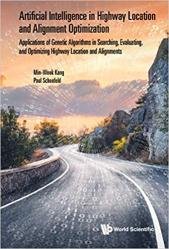 Название: Artificial Intelligence In Highway Location And Alignment Optimization: Applications Of Genetic Algorithms In Searching, Evaluating, And Optimizing Highway Location And Alignments
Название: Artificial Intelligence In Highway Location And Alignment Optimization: Applications Of Genetic Algorithms In Searching, Evaluating, And Optimizing Highway Location And AlignmentsАвтор: Min-Wook Kang, Paul Schonfeld
Издательство: World Scientific Publishing
Год: 2021
Страниц: 289
Язык: английский
Формат: pdf (true), epub
Размер: 60.7 MB
This monograph provides a comprehensive overview of methods for searching, evaluating, and optimizing highway location alignments using genetic algorithms (GAs), a powerful Artificial Intelligence (AI) technique. It presents a two-level programming structure to deal with the effects of varying highway location on traffic level changes in surrounding road networks within the highway location search and alignment optimization process. In addition, the proposed method evaluates environmental impacts as well as all relevant highway costs associated with its construction, operation, and maintenance. The monograph first covers various search methods, relevant cost functions, constraints, computational efficiency, and solution quality issues arising from optimizing the highway alignment optimization (HAO) problem. It then focuses on applications of a special-purpose GA in the HAO problem where numerous highway alignments are generated and evaluated, and finally the best ones are selected based on costs, traffic impacts, safety, energy, and environmental considerations. A comprehensive review of other promising optimization methods for the HAO problem is also provided in this monograph.
Artificial Intelligence (AI) is a field of study that synthesizes and analyzes computational agents that act intelligently. AI, however, is normally characterized as computer applications in engineering fields that show features similar to intelligence of living creatures, such as evolution, collaborative behavior, processing of natural language, dealing with spatial structures, logical reasoning with fuzzy concepts, and learning. Therefore, heuristic and metaheuristic methods, designed for solving complex problems through a process of learning and discovery, are considered as a core field of AI in engineering. Several AI methods have been applied in highway location and alignment optimization problems. These include (i) Genetic Algorithms (GAs), (ii) Swam Intelligence (SW), and (iii) Simulated Annealing (SA). This book discusses computer applications or models that used those AI methods to solve highway location and alignment optimization problems.
Genetic algorithms (GAs), derived from Darwin’s theory on genetic evolution, are an AI method that has been popularly employed for solving complex optimization problems that cannot easily be solved by traditional analytical approaches. GAs are adaptive search methods based on the principles of natural evolution and survival of the fittest. Among many different methods proposed for highway location selection and alignment optimization, GAs have been the most widely-investigated due to their ability to realistically handle the complex fitness functions featuring nonlinearities and discontinuities while including mechanisms to escape local optima. GAs with effective constraint handling methods can avoid getting trapped in local optima and yield near optimal solutions in a continuous search space, by providing a pool-based search rather than single solution comparison as in other heuristics. In practice, this AI method has proven to be simple, fast, and effective.
Readership: The monograph is a valuable reference for graduate and postgraduate researchers who seek to solve transportation system and network optimization problems using Artificial Intelligence techniques.
Скачать Artificial Intelligence In Highway Location And Alignment Optimization: Applications Of Genetic Algorithms